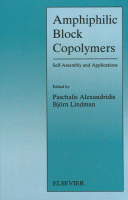Browse content
Table of contents
Actions for selected chapters
- Full text access
- Book chapterNo access
Amphiphilic molecules: small and large
Björn Lindman and Paschalis Alexandridis
Pages 1-12 - Book chapterNo access
Modelling of the self-assembly of block copolymers in selective solvent
P. Linse
Pages 13-40 - Book chapterNo access
On the origin of the solution behaviour of ethyleneoxide containing polymers
Gunnar Karlström
Pages 41-55 - Book chapterNo access
Block copolymers of ethylene oxide and 1,2-butylene oxide
C. Booth, G.-E. Yu and V.M. Nace
Pages 57-86 - Book chapterNo access
Self-Assembly of Block Polyelectrolytes
Lifeng Zhang, Karine Khougaz, ... Adi Eisenberg
Pages 87-113 - Book chapterNo access
Formation of Amphiphilic Block Copolymer Micelles in Nonaqueous Solution
T. Liu, L.-Z. Liu and B. Chu
Pages 115-149 - Book chapterNo access
Structures of amphiphilic block copolymers in their liquid and solid states
Anthony J. Ryan, Shao-Min Mai, ... Ian W. Hamley
Pages 151-167 - Book chapterNo access
Structural Polymorphism of Amphiphilic Block Copolymers in Mixtures with Water and Oil: Comparison with Solvent-Free Block Copolymers and Surfactant Systems
Paschalis Alexandridis, Ulf Olsson, ... Björn Lindman
Pages 169-190 - Book chapterNo access
Small-Angle Scattering Studies of Block Copolymer Micelles, Micellar Mesophases and Networks
Kell Mortensen
Pages 191-220 - Book chapterNo access
Fluorescence studies of amphiphilic block copolymers in solution
R. Zana
Pages 221-252 - Book chapterAbstract only
Direct-Imaging Cryo-Transmission Electron Microscopy in the Study of Colloids and Polymer Solutions
Marganit Goldraich and Yeshayahu Talmon
Pages 253-280 - Book chapterNo access
Rheology Of Transient Networks Formed By The Association Of Hydrophobically Modified Water Soluble Polymers
Tom Annable, Richard Buscall and Rammile Ettelaie
Pages 281-304 - Book chapterNo access
Applications of block copolymers
K. Holmberg
Pages 305-318 - Book chapterNo access
Block copolymers in pharmaceutics
M. Malmsten
Pages 319-346 - Book chapterNo access
Micelles of amphiphilic block copolymers as vehicles for drug delivery
Alexander V. Kabanov and Valery Yu. Alakhov
Pages 347-376 - Book chapterNo access
Applications of Amphiphilic Copolymers in Separations
Mårten Svensson, Hans-Olof Johansson and Folke Tjerneld
Pages 377-407 - Book chapterNo access
Polymeric Surfactants as Emulsion Stabilizers
R. Pons
Pages 409-422 - Book chapterNo access
Subject Index
Pages 423-435
About the book
Description
It is the belief of the editors of this book that the recognition of block copolymers as being amphiphilic molecules and sharing common features with other well-studied amphiphiles will prove beneficial to both the surfactant and the polymer communities. An aim of this book is to bridge the two communities and cross-fertilise the different fields. To this end, leading researchers in the field of amphiphilic block copolymer self-assembly, some having a background in surfactant chemistry, and others with polymer physics roots, have agreed to join forces and contribute to this book.
The book consists of four entities. The first part discusses theoretical considerations behind the block copolymer self-assembly in solution and in the melt. The second part provides case studies of self-assembly in different classes of block copolymers (e.g., polyethers, polyelectrolytes) and in different environments (e.g., in water, in non-aqueous solvents, or in the absence of solvents). The third part presents experimental tools, ranging from static (e.g., small angle neutron scattering) to dynamic (e.g., rheology), which can prove valuable in the characterization of block copolymer self-assemblies. The fourth part offers a sampling of current applications of block copolymers in, e.g., formulations, pharmaceutics, and separations, applications which are based on the unique self-assembly properties of block copolymers.
It is the belief of the editors of this book that the recognition of block copolymers as being amphiphilic molecules and sharing common features with other well-studied amphiphiles will prove beneficial to both the surfactant and the polymer communities. An aim of this book is to bridge the two communities and cross-fertilise the different fields. To this end, leading researchers in the field of amphiphilic block copolymer self-assembly, some having a background in surfactant chemistry, and others with polymer physics roots, have agreed to join forces and contribute to this book.
The book consists of four entities. The first part discusses theoretical considerations behind the block copolymer self-assembly in solution and in the melt. The second part provides case studies of self-assembly in different classes of block copolymers (e.g., polyethers, polyelectrolytes) and in different environments (e.g., in water, in non-aqueous solvents, or in the absence of solvents). The third part presents experimental tools, ranging from static (e.g., small angle neutron scattering) to dynamic (e.g., rheology), which can prove valuable in the characterization of block copolymer self-assemblies. The fourth part offers a sampling of current applications of block copolymers in, e.g., formulations, pharmaceutics, and separations, applications which are based on the unique self-assembly properties of block copolymers.
Details
ISBN
978-0-444-82441-7
Language
English
Published
2000
Copyright
Copyright © 2000 Elsevier B.V. All rights reserved
Imprint
Elsevier Science
